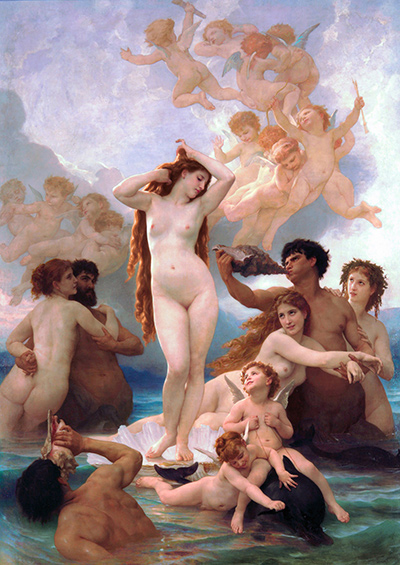William-Adolphe Bouguereau painted The Birth of Venus (La Naissance de Vénus) in 1879. It was originally commissioned for the Paris Salon.
It was then later purchased to be housed in the Musée du Luxembourg. The painting also won the prestigious honour of the Grand Prix de Rome. The canvas measures a staggering 9ft by 7ft.
Although The Birth of Venus is a highly original artwork, it does offer many similarities to The Triumph of Galatea by Raphael and, The Birth of Venus as portrayed by Sandro Botticelli.
During the 19th century, artists of the same period painted images from history and biblical times, as well as citing cultural and intellectual references in their artistic work. They also studied the female form and perfected painting women in all of their natural and unadorned beauty.
As a result, many of these paintings became an eclectic mix of images that portrayed females on canvas in a stylish, sensual and sometimes seductive manner. Bouguereau, became a member of the Art Academy in 1876, and he was one of the first artists to create paintings in such an artistic manner.
He was also a devout Catholic and this greatly influenced both his subject matter and the style of his painting.
The Birth of Venus by Bouguereau is one painting from many that were born of the same subject, that of the goddess Venus. During the Renaissance period, Sandro Botticelli painted his own version of Venus, and it is obvious that from viewing Bouguereau's painting, that he drew both inspiration and passion from the great master, in order to create his own personalised version of Venus.
When we view The Birth of Venus by Bouguereau, what we observe is Venus, stood, at the central point of the painting, and she is naked. Our eyes automatically focus upon her nude body. This is in keeping with the fact that she has just been born, and has risen from the sea.
This fact is further reiterated as we observe her standing on a floating platform that is encrusted with what appears to be scallop seashells. When we look more closely, we then see that she is being pulled along in the water by a beautifully painted dolphin.
The dolphin is one of Venus's iconic water symbols. The rest of the painting is taken up with several mythical and fantastic creatures, that all surround and stare in wonder at the beauty of Venus. These figures include Psyche, nymphs, centaurs and Cupid. Two of the centaurs appear to be blowing into shells, as if they are announcing the birth of Venus. Everyone else is staring at her beauty and welcoming her after the birth.
Venus is beautiful, feminine and other worldly, and Bouguereau has clearly depicted this in his painting. This is shown through the slight tilt of her head, her calm, peaceful, facial expression and the fact that she is completely relaxed and at peace with her nudity before others.
Bouguereau has enhanced the curvaceous lines of her body, by allowing her to throw her arms into the air, therefore freeing her hair to fall gently around her shoulders.
Bouguereau's muse for The Birth of Venus was that of Marie Georgine, who was a princess. The two met when she visited Paris in 1861, while with her lover. Together, the couple modelled for Bouguereau's paintings of Flora and Zephyr and the Abduction of Psyche.
When he began to paint The Birth of Venus, he referred back to he pictures and sketches that he had used on these two previous works.
What many critics cannot agree on is the emotions that are depicted in this painting. Many art critics argue that there is very little emotion and passion emanating from Venus. There is no argument about artistic skill and, that the individuals have been portrayed perfectly in stature and image, but many argue that the characters involved all lack feeling, possibly due to the contemporary nature of the painting.
This may influence the observer, making the images come across as being too contrived. However, what cannot be disputed is artistic style, talent and the fact that Bouguereau was incredibly popular, successful and inspirational.




